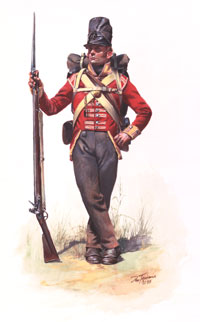The Canadian militia in the War of 1812 has received much attention but what is often forgotten is that regular Canadian soldiers also fought in the conflict — and fought well. The five fencible corps and the various units raised by the provincial governments constituted an important component of the defence of British North America. There was, however, only one Canadian regiment “of the line,” meaning a unit of the British Army liable for service anywhere in the globe. That unit was the 104th (New Brunswick) Regiment of Foot, and in this book John Grodzinski tells its story.
Although the author concentrates on the record of the 104th Foot during the war years of 1812-1815, he provides a proper context for the unit’s history, discussing its early days up to the outbreak of hostilities. He also admirably dissects the complexities of the British Army’s arcane system of organization, recruiting, and promotion.
The author rightfully spends time on the seven-hundred-mile epic march from Fredericton to Kingston made by six companies of the 104th in the late winter of 1812-1813. This notable feat of arms — almost certainly the longest winter march made by a British regiment up to that time — is covered in detail, particularly its logistical arrangements, because marching troops in the winter is one thing, but feeding them along the way is quite another. It is only fitting that, two centuries later, volunteers and personnel from militia units along its course restaged this journey to commemorate the wartime original. As John Grodzinski reminds us, however, perhaps too much attention can be paid to this aspect of the history of the 104th Foot because it also saw considerable active service.
The unit’s first combat occurred when it participated in the raid on Sackets Harbor, New York, in late May 1813. The 104th performed well but suffered heavy casualties. Following this incident, it deployed to the Niagara Peninsula, where it spent a frustrating and sickly summer as part of the British force blockading the American-held Fort George near present-day Niagara-on-the-Lake.
In the autumn of 1813, it was brought back to Kingston when American forces threatened the St. Lawrence lifeline, and remained there over the winter. In the following summer, the two flank, or elite, companies of the 104th were again sent to the Niagara, where they fought in some of the bloodiest actions of the war, including the vicious nighttime battle of Lundy’s Lane, the bloody assault on Fort Erie, and the action at Cook’s Mills. With the coming of peace, most of the regiment was concentrated in Lower Canada, where it remained until disbanded in 1817.
Although John Grodzinski stresses the bright high points of the history of the 104th Foot, he does not neglect the darker areas, and discusses problems of leadership, desertion, and illness. The result is a complete but compact history of a Canadian military unit that has long been overlooked.
It is only fitting that the bicentenary of the War of 1812 has resulted in the full restoration of the wartime Colours of the 104th Foot. Even more welcome is the decision of the federal government to allow units of the modern Canadian Army to perpetuate units of that earlier conflict and to receive the Battle Honours gained by them during the War of 1812. Thus, the modern Royal New Brunswick Regiment is officially linked with the 104th (New Brunswick) Regiment of Foot and has received the two Battle Honours, “Defence of Canada, 1812-1815” and “Niagara, 1814,” earned by its predecessor.
Donald E. Graves
“Maple Cottage”
Valley of the Mississippi
Upper Canada
